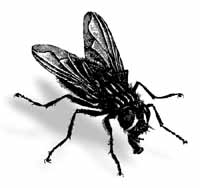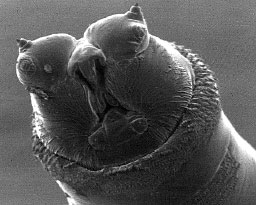|
HOME |
|
|
HOME |
|
The common house fly is a common flying insect that is found throughout the world.


ANATOMY
Like all insects, the house fly has a body divided into three parts (head, thorax, and abdomen), a hard exoskeleton, and six jointed legs. Flies also have a pair of transparent wings. The house fly can taste using its its feet and with its mouthparts. Adults are about 6 - 9 mm long with 13 - 15 mm wingspan.
House flies are dark gray, with four dark stripes down the top of the thorax. They have sponging mouthparts (they cannot bite); house flies can only eat liquids, but they can liquefy many solid foods with their saliva.
|
|
This is a hugely magnified picture of the mouth of a fruit fly. It is taken using an electron microscope. You can see the eyes on either side. (There is a copyright watermark over the top of the picture) |
REPRODUCTION
The complete life-cycle of a house fly takes from 10 to 21 days. On the average, 12 generations of house flies can be produced in one year. Adult females lay 120-150 tiny white eggs, usually in manure or other warm, moist, decaying organic matter.
A female lives for about 2 and a half months and can lay up to 1,000 eggs in her short life. The eggs are only about 1 mm long and hatch into white, worm-like maggots in about 12 hours.
The maggots grow to be about 1/2 inch (12.5 cm) long. When they are this big, they burrow into the ground to pupate. An adult will emerge in about 5 to 6 days (in warm weather) or about a month (in cold weather).
DISEASE CARRIER
The House Fly is often a carrier of diseases, such as typhoid fever, cholera, dysentery, and anthrax. The fly transmits diseases by carrying disease organisms on to food. It picks up disease organisms on its leg hairs and the sticky pads at the base of its claws, or eats them and then regurgitates or excretes them on to food.
House flies have been shown to harbor over 100 different kinds of disease, many of which are associated with filth. Examples are typhoid fever, cholera, diarrhea, dysentery, tuberculosis, anthrax, ophthalmia, polio, and salmonellosis, as well as parasitic worms.
HABITS
Although house flies have been shown to migrate up to 30 km, most stay within 2 km of their release point or larval habitat if enough food is available.
During the day, house flies tend to rest less than 1.5 m from the ground on walls, floors, and various objects. At night they rest mainly above 1.5 m on ceilings, walls, electric wires, dangling light cords, edges/corners of buildings, plants, etc. Their night resting places are usually near their daytime food sources.
 |
This is a hugely magnified picture of the mouth of a blowfly maggot. Charming, isn't it? |